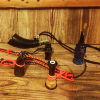Olon
Member
Howdy,
Every coyote I've shot has been taken while I'm out baling hay, checking cattle, etc. It was a "happy accident." I've moved and I don't do that ranch work anymore, but I've taken to coyote hunting. The challenge of calling them in and trying to best them in their own game is alluring.
After 3 or so months of unsuccessful hunts with no sighting, I'm beginning to wonder if there's something I'm missing. I've probably watched hours of youtube and learned things like checking the wind, using cover, not skylining myself and even types of calls. When it comes to the hunt, I just can't seem to outsmart those wiley critters.
I use a coyote howler (a FoxPro open reed type deal), and hunt the areas I go to for small game. There is coyote sign galore. Picked apart carcasses, tracks, scat, you name it. It's all there but no yotes to show. Beginning to think that they go to those areas at night and steer clear during the day. It's public land, but even so I've only seen human tracks in that particular area twice in my 6 or so months of hunting that ground.
My question is this: will coyotes respond to an "invitation howl"? If I make a decent howl within earshot of a coyote, is there a good likelihood they will respond, or do they just come in for you guys? I'm thinking if they respond I can figure out where they are and aren't during the day, wheras it's a bit more of a crapshoot if they just silently come in.
Any pro tips from you seasoned coyote hunters? I'm hunting in Eastern Nebraska. Lots of grassy pastures, some rolling hills and the occasional creek with trees all along it.
Thanks for your responses,
Olon
Every coyote I've shot has been taken while I'm out baling hay, checking cattle, etc. It was a "happy accident." I've moved and I don't do that ranch work anymore, but I've taken to coyote hunting. The challenge of calling them in and trying to best them in their own game is alluring.
After 3 or so months of unsuccessful hunts with no sighting, I'm beginning to wonder if there's something I'm missing. I've probably watched hours of youtube and learned things like checking the wind, using cover, not skylining myself and even types of calls. When it comes to the hunt, I just can't seem to outsmart those wiley critters.
I use a coyote howler (a FoxPro open reed type deal), and hunt the areas I go to for small game. There is coyote sign galore. Picked apart carcasses, tracks, scat, you name it. It's all there but no yotes to show. Beginning to think that they go to those areas at night and steer clear during the day. It's public land, but even so I've only seen human tracks in that particular area twice in my 6 or so months of hunting that ground.
My question is this: will coyotes respond to an "invitation howl"? If I make a decent howl within earshot of a coyote, is there a good likelihood they will respond, or do they just come in for you guys? I'm thinking if they respond I can figure out where they are and aren't during the day, wheras it's a bit more of a crapshoot if they just silently come in.
Any pro tips from you seasoned coyote hunters? I'm hunting in Eastern Nebraska. Lots of grassy pastures, some rolling hills and the occasional creek with trees all along it.
Thanks for your responses,
Olon
Last edited:


